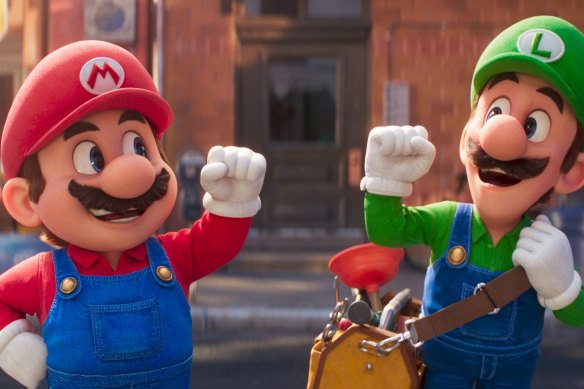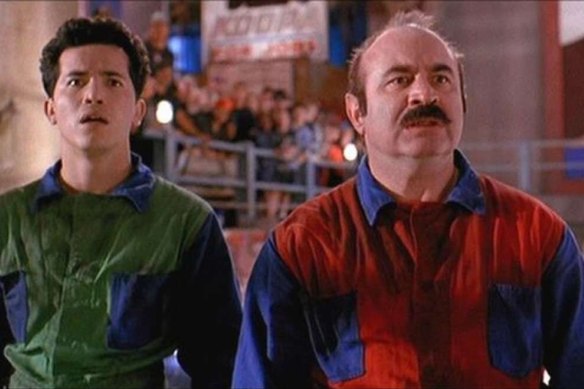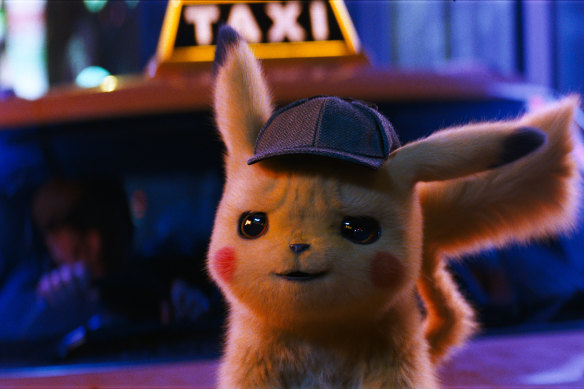By Nell Geraets
This week everyone’s favourite plumber returned to cinemas for the first time in 30 years with the release of The Super Mario Bros. Movie, starring Chris Pratt. While the first film, a live-action adaptation released in 1993, was a bomb that famously deterred Nintendo – one of the biggest game companies in the world – from making more movies, the latest iteration is expected to be one of the biggest releases of the year.
Illumination’s Super Mario Bros. Movie is projected to make $190 million in its first five days in cinemas. If this eventuates, it will be the second-best opening week debut for the animation studio beaten only by Despicable Me 2 (2013), which grossed $213 million over the same period.

Super Mario Bros. (2023) is projected to be a huge hit, after opening in cinemas this week.
So, what’s changed? The anticipated success of the film is part of a much bigger story about how game adaptations are made, how they’re viewed by audiences and what we now regard as quality cinematic entertainment.
The original Super Mario Bros. film, released in 1993 and backed by the now-defunct Hollywood Pictures division of Walt Disney Studios, was both a critical and commercial flop. It made just $14 million during its opening week in the United States and Canada, and grossed about $31 million overall – less than half of its $62 million production budget. And reviewers were equally unenthused, lamenting the gratuitous use of explosions and kitschy costumes, and taking issue with the over-complicated storyline that failed to pay homage to the original game. “The movie knocks your eyes out, at the same time it dulls the mind’s eye,” Los Angeles Times reporter Michael Wilmington wrote at the time of its release.

Mario (Bob Hoskins) and Luigi (John Leguizamo) in the 1993 version of the Super Mario Bros. movie.Credit: Buena Vista Pictures Distribution
Despite the star power of Kylie Minogue and Jean-Claude Van Damme, the 1994 film Street Fighter was also ripped to shreds, receiving an abysmal 20 per cent audience score on Rotten Tomatoes and just 11 per cent from critics. It was, however, one of few adaptations in the decade to turn a profit, grossing about $147 million worldwide – nearly three times its production budget.
Film critic and comedian Alexei Toliopoulos said much of this was due to the fact video games were still a developing form of media in the ’90s. Filmmakers couldn’t depend on a significant pre-existing fan base and had weaker storylines to work with too.
“People didn’t understand what games culturally meant to audiences,” Toliopoulos said. “At that time, video games had interactive media at the forefront. Storytelling was less of a priority.”
Dr Matthew Harrison, a researcher in digital games-based learning at the University of Melbourne, said the film industry also simply didn’t consider video games a serious creative art form at the time.
“The perception of movie studios was that [game adaptations] were a quick way to use name recognition from a popular activity for children, and to be able to get people into the cinema with their parents without having to worry about things like plot development,” Harrison said.
What’s changed over the past couple of decades is the enormous growth of the video game industry, especially relative to films. Harrison said it’s more or less accepted now that video games were more profitable than films, partly due to rising interest from a ballooning middle class in the Asia-Pacific region.
In 1993, revenue for the global gaming industry was equivalent to $55.2 billion (adjusted for inflation). By 2013, Grand Theft Auto V made $1 billion worldwide in three days, making it the fastest-selling entertainment product at the time. It was a turning point for the industry, and things have only accelerated since.
A recent PwC report noted that global video games revenue rose 32 per cent between 2019 and 2021, and the industry was expected to be worth $479.3 billion by 2026. This week, Australian drinks retailer Endeavour Group invested $3 million into Sydney’s newest e-gaming centre, Fortress, showing just how mainstream the medium has become.
Mark Johnson, a digital cultures scholar at the University of Sydney, said this growth had triggered a shift in the cultural power between mediums.
“Rather than films being seen as the core media and games being seen as adaptations, we’re now seeing the reverse,” he said. “There’s also a real prestige difference, as games based on films and television are still normally critically panned and have very little impact on gaming ... Yet television and film based on games are becoming more accepted.”
People are also choosing to watch other gamers play on platforms like Twitch or YouTube for recreation, which is almost like a midway point between watching a film and gaming.
Last year, Twitch – a video game live-streaming platform – gained 11 million new streamers and users watched 21 billion hours of content. YouTube gamers like Markiplier have upwards of 30 million subscribers.
As CGI and visual effects improve, many video game creators are also turning their focus to meatier narratives – something that lends itself well to film.
So, what does this all mean for contemporary video game adaptations? Nearly three decades after the first Super Mario Bros. movie, filmmakers are once again braving the video game world – and they’re levelling up.

Detective Pikachu, voiced by Ryan Reynolds, in a scene from “Pokémon: Detective Pikachu.”Credit: Warner Bros Pictures
The 2019 release of Pokémon: Detective Pikachu – based on a niche spinoff game from the Pokémon franchise – was more warmly received by critics and grossed $634 million worldwide.
It became a global hit largely thanks to its delicate weaving of the film noir genre and the original video game universe. Toliopoulos said, unlike game adaptations from the ’90s, this film accurately interpreted gamers’ relationships with the original game instead of taking needless creative license.
Sonic The Hedgehog, released in 2020, enjoyed similar success: it grossed $449 million and earned a whopping 94 per cent audience score on Rotten Tomatoes. And Uncharted, a 2022 game adaptation starring Tom Holland, made $592 million worldwide as both gamers and non-gamers alike found enjoyment in its solid plot.
TV is also benefiting from the game-adaptation boom. This year’s The Last of Us is inspired by the survival-horror game set in a zombie-infested apocalyptic future. According to HBO, just one episode pulled in an overnight audience of 6.4 million US viewers.
Video games have proven such a boon for the film and television industry that creators are also now borrowing from role-playing games like Dungeons & Dragons and mobile games like Angry Birds. And with upcoming adaptations like Return to Silent Hill and Minecraft: The Movie on the horizon, audiences will be poised to determine whether video games really are the new “final boss”.
A cultural guide to going out and loving your city. Sign up to our Culture Fix newsletter here.